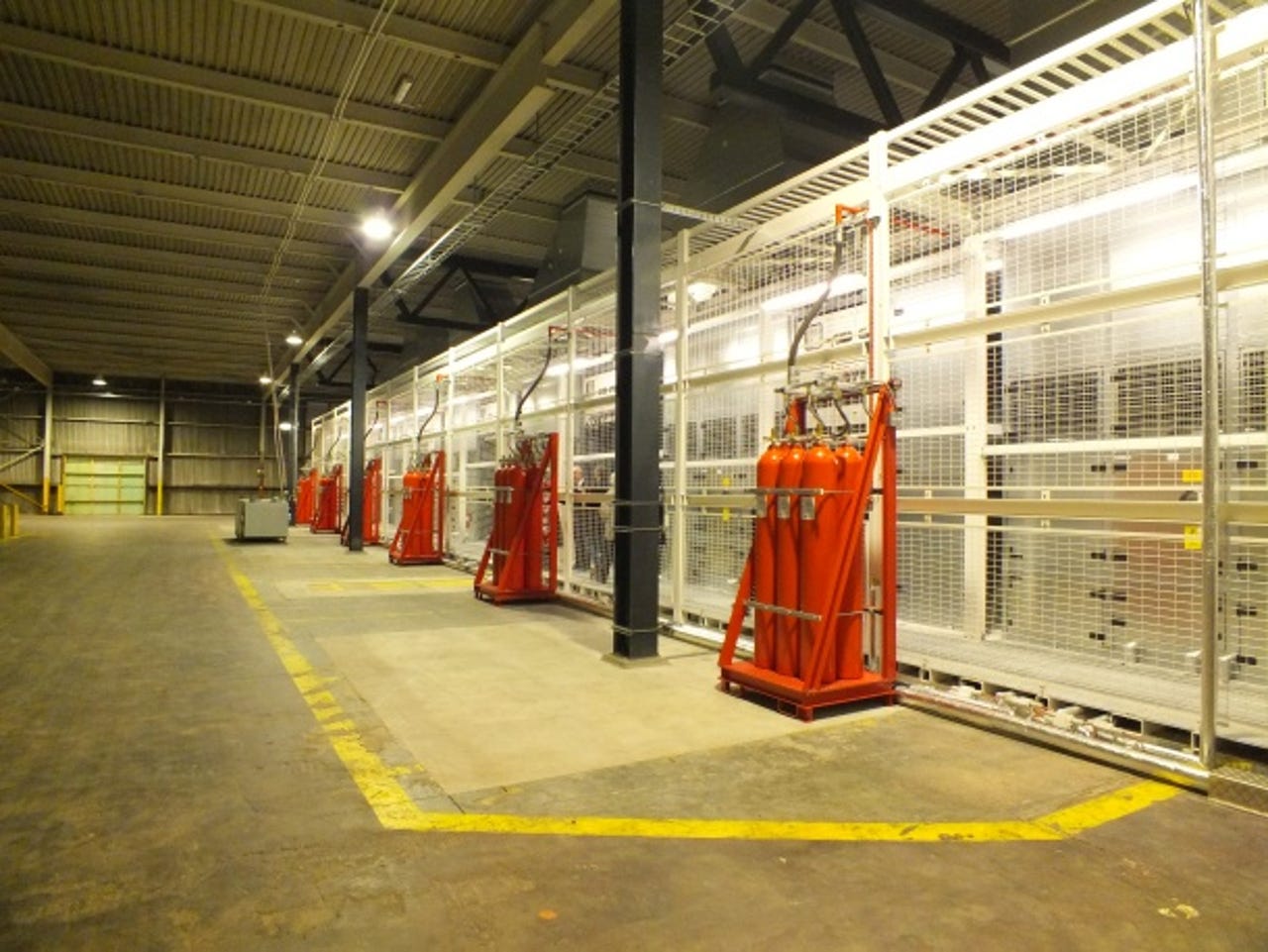Inside an Icelandic datacentre

Datacentre exterior
Iceland, with its abundant geothermal resources, is aiming to become a destination for low-cost datacentres, and colocation specialist Verne Global is one of the first to set up a facility in the country.
ZDNet UK visited Iceland in February to see how Colt's modular datacentre design fared after being shipped to a remote country and installed in an ex-NATO military base for Verne Global.
Initially, Verne Global's facility is using one Colt module. This consumes around 1.5MW of power, ZDNet UK understands. The site has a substation that can supply up to 60MW of power, and the company has secured guaranteed low-cost electricity from Icelandic utility Landsvirkjun for the next 20 years.
State-owned Landsvirkjun is able to provide Verne Global with 100-percent 'green' electricity, as it generates power from renewable hydroelectric and geothermal sources native to Iceland.
The power constraints on datacentres in metropolitan European cities could tempt businesses into locating their data in Iceland, Verne Global believes. Moving there would also allow them to use a fully 'green' datacentre and avoid the outcry that Facebook experienced from Greenpeace when it used coal-sourced power for its Prineville, Oregon facility.
"You have power availability in the European area pressing down on the providers, carbon regulations, rising operational costs and all that, coupled with an explosion of data," said Tate Cantrell, Verne Global's chief technology officer. "If someone thinks that Iceland's not a secure place to store data, I challenge anyone on that one."
Datacentre interior
Colt's modules are built to a standardised internal design that uses columns to wire the facility with environmental and security sensors, fire suppression, and other services. If need be, they can also host power sockets and additional security cameras, depending on the customer's needs.
They also serve a structural purpose, according to Guy Ruddock, Colt's datacentre and real estate implementation director. "They play a key role in allowing us to double-stack the datacentres, by keeping the overall height down," he said.
Datacentre corridor
Some of the first companies to take space in the facility include GreenQloud, which runs a public cloud service that prides itself on its environmental credentials.
The producer of popular online role-playing game Eve Online has also taken an undisclosed amount of space to use for testing and development, though the main game lives on a supercomputer named 'Tranquility' in a Docklands datacentre in London for latency reasons.
Underfloor cabling
Above, Colt's Guy Ruddock shows off the datacentre's underfloor cabling.
Unlike some datacentre companies, Colt can handle both underfloor and overhead cabling, according to customer preference: Verne Global opted for underfloor cabling. This helps air circulate in and out of the enclosed server aisles, the company said.

Colt datacentre modules
Iceland has a relatively mild climate, with temperatures rarely deviating beyond a low of -8°C and a high of 16°C, according to data from Wolfram Alpha.
"Having been an engineer in Alaska, I don't like designing [facilities] when it's -20, -30, -40°," Cantrell said. "I like the temperate climate in Iceland."
This makes the country ideal for free-cooled datacentres and so, in an unusual move for Colt, it delivered its module to Verne Global without any direct-expansion chillers. "We also upgraded the [air] filtration system and installed mild winterisation heating in front of the UPS as a precaution," Ruddock said.
The ability to use external air all year round and Colt's relatively efficient modular design means the facility should attain a power usage effectiveness (PUE) of around 1.2, Cantrell said.
Colt's modules (pictured) can be installed in a basic warehouse shell. In the case of volcanic eruptions or sudden spikes in temperature, the modules can seal themselves off to prevent airborne particles damaging the server and to keep temperature stable.
Module systems
Colt's modules are built to an exoskeletal design where their power distribution (pictured), cooling and fire-suppression systems are placed on the outside of the module. This means they can be maintained without having to have lots of people traipsing in and out of the server rooms.
Computer-generated image of the datacentre complex
The initial module lives in the KEF101 warehouse complex (pictured) of an old NATO airbase. Verne Global has taken a lease on the entire site, which gives it access to a further 200,000 to 250,000 square feet of space for IT expansion.
Because the site is an old airbase, it is located in one of the most geologically stable areas of the country, according to Tate Cantrell, Verne Global's chief technology officer. The US conducted a thorough environmental survey before helping to set up the base, he said.
In 2010, a volcanic eruption in Iceland disrupted air travel across Europe and covered much of the country in a cloud of ash. The NATO base is located in such a way that Arctic breezes and the Gulf Stream combined to push volcanic effects away from the facility, according to Verne Global.
Get the latest technology news and analysis, blogs and reviews delivered directly to your inbox with ZDNet UK's newsletters.